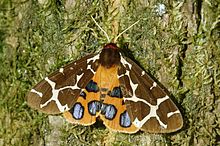Brown bear (butterfly)
| Brown bear | ||||||||||||
|---|---|---|---|---|---|---|---|---|---|---|---|---|

Brown bear ( arctia caja ) |
||||||||||||
| Systematics | ||||||||||||
|
||||||||||||
| Scientific name | ||||||||||||
| Arctia caja | ||||||||||||
| ( Linnaeus , 1758) |
The brown bear ( Arctia caja ) is a butterfly ( moth ) from the subfamily of the bear moth (Arctiinae).
features
The moths have a wingspan of 45 to 65 millimeters. The drawing of the wings varies considerably: the front wings are brown with a white, large-meshed net pattern and elongated spots that extend from the front edge. The white pattern can also be absent, or the forewings can be almost entirely white. The hind wings are vermilion with large, black or black-edged blue dots.
The egg is flattened at the base and white to greenish.
The long-haired caterpillar can measure up to six centimeters. It's black with white warts. The hair is black-brown with gray tips on the back and rust-red on the sides and front.
The pupa is black-brown with protruding wing sheaths. The cremaster has bristles with small bulges at the end.
Geographical distribution and habitat
The brown bear is widespread throughout Europe as far as Lapland , Asia and North America . This species can be found in the mountains up to an altitude of 2,000 meters. The brown bear is found in a wide range of habitats. It includes the entire forest (outer and inner fringes, roadsides, aisles, clearings and moist forest meadows), but also the open landscape rich in bushes. Places such as extensively managed meadows, low and high moors, grasslands, dams, roads and banks, as well as abandoned and cultivated land (parks, gardens and fallow fields) and sand and gravel pits.
Way of life
The brown bear forms only one generation per year, whose moths fly from July to September. Due to their nocturnal lifestyle, the butterflies are seldom seen unless in a light source that they always fly to. The eye-catching color patterns on the wings serve to warn predators of the brown bear. This has poisonous hemolymph , the effect of which is not yet fully understood. The colors are also ideal for frightening predators such as the titmouse : the brown bear sits on the trunk in such a way that the bird initially only sees the brown-spotted side. When it approaches, the brown bear shows the red color of the hind wings at lightning speed and flies away. So he successfully confuses the bird. The eggs are laid from July in the form of large, bluish-white clutches on the underside of the leaves of the host plants. The caterpillars hatch in August. The caterpillars of the brown bear feed on many herbs, such as B. Meadow sorrel ( Rumex acetosa ), blunt-leaved dock ( Rumex obtusifolius ), great nettle ( Urtica dioica ), meadowsweet ( Filipendula ulmaria ) and many others, but also eat raspberries ( Rubus idaeus ), blackberries ( Rubus fruticosus aggr.) On bushes, Snowball ( Viburnum ), red dogwood ( Cornus sanguinea ) and red honeysuckle ( Lonicera xylosteum ) etc. a. and trees such as silver willow ( Salix alba ), ear willow ( Salix aurita ), sal willow ( Salix caprea ), English oak ( Quercus robur ). They pretend to be dead in case of danger. The caterpillars overwinter on the ground in sheltered places. They pupate in the following year from June to July in a dense, hair-mixed web on the ground between stems. The moths hatch from July to August.
Hazard and protection
The brown bear is particularly protected by the Federal Nature Conservation Act. On the Red List of Endangered Animal Species of the Federal Republic of Germany, it is a kind of warning list. In Baden-Württemberg and Saarland it is considered endangered (category 3). In Austria, the species is in decline in all parts of the country, like hardly any other butterfly species. The species is considered to be a highly sensitive bio-indicator for near-natural biocenoses and as a refugee from culture .
swell
Individual evidence
- ↑ Walter Forster , Theodor A. Wohlfahrt : The butterflies of Central Europe. Volume 3: Weirdos and Swarmers. (Bombyces and Sphinges). Franckh'sche Verlagshandlung, Stuttgart 1960, DNB 456642196 (2nd edition, 1984, ISBN 3-440-05279-6 ).
- ↑ Red Lists
- ↑ Gerfried Deschka, Josef Wimmer: The butterfly fauna of the cross wall. Contribution Natural Upper Austria, 2000
literature
- Günter Ebert (Ed.): The butterflies of Baden-Württemberg. Volume 5: Moths III (Sesiidae, Arctiidae, Noctuidae). Ulmer Verlag, Stuttgart 1997, ISBN 3-8001-3481-0 .


